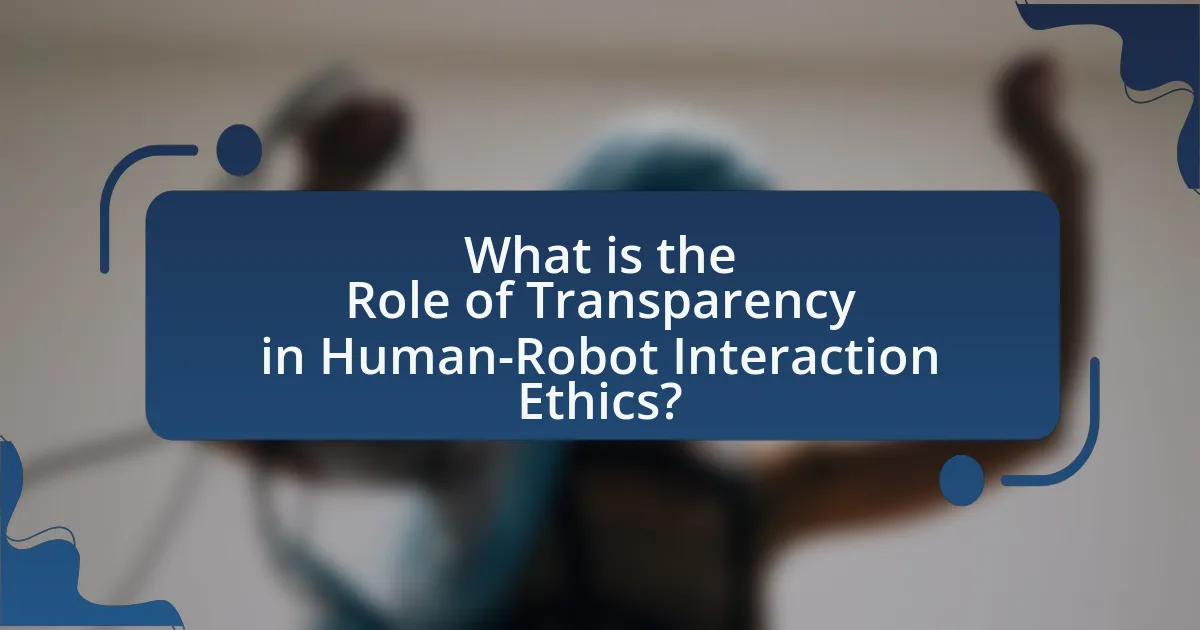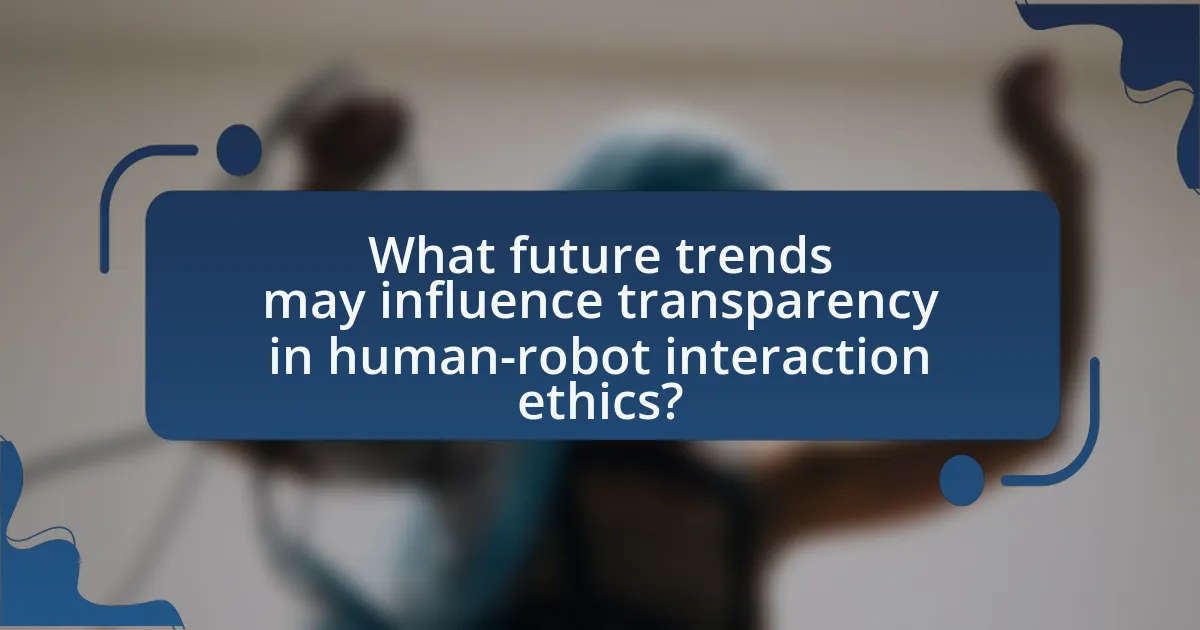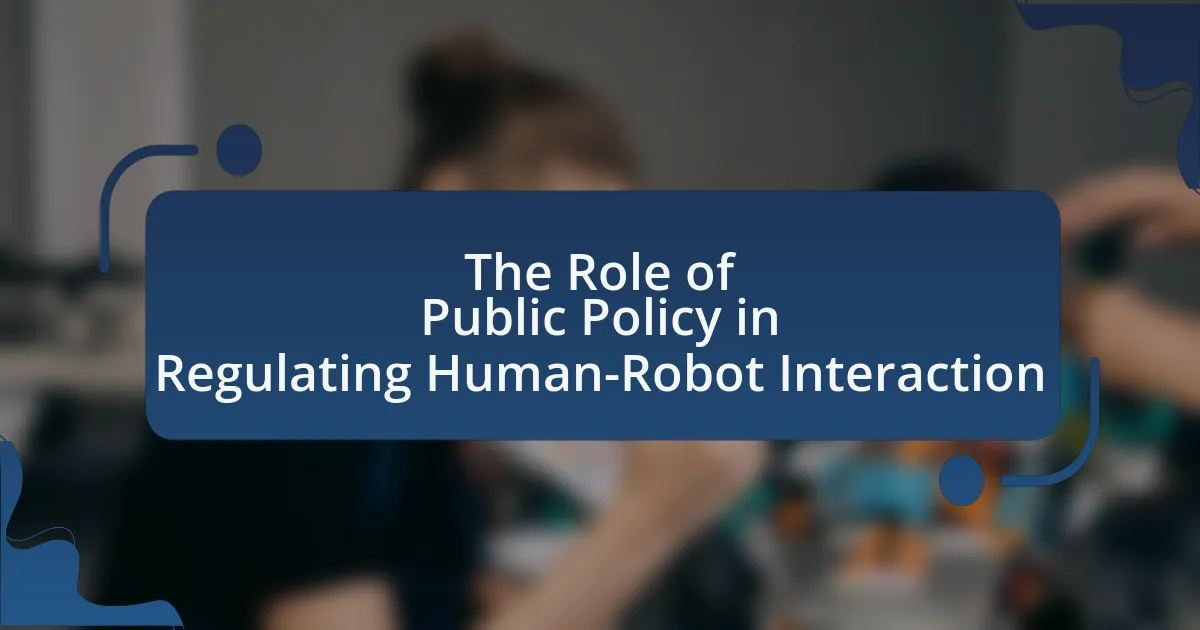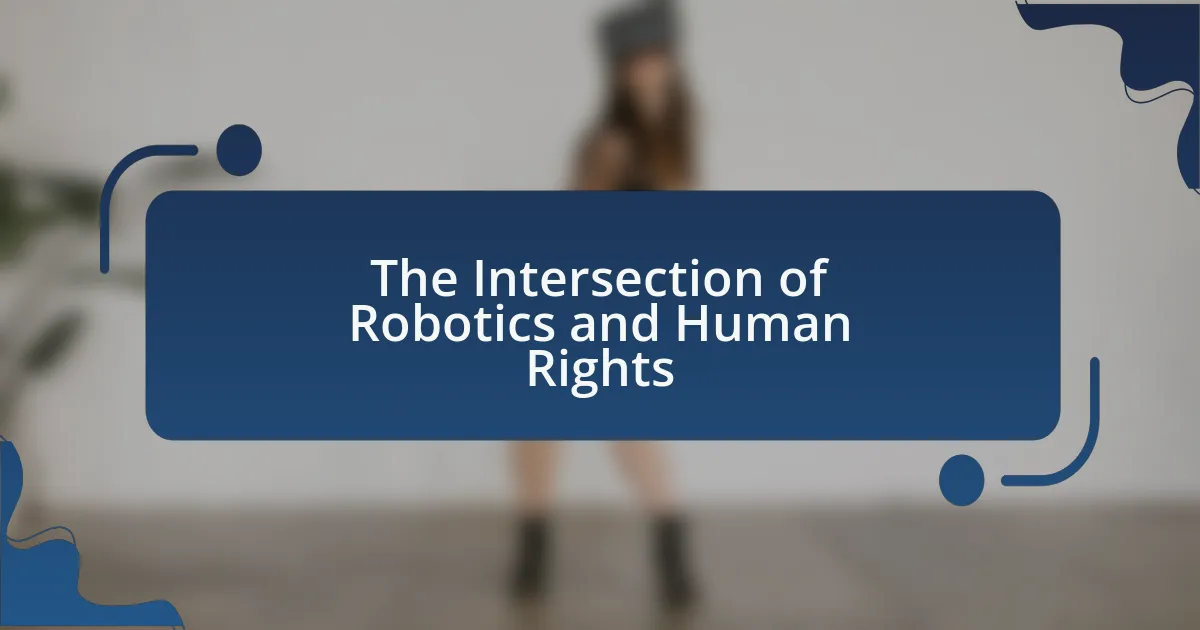The article examines the critical role of transparency in human-robot interaction ethics, emphasizing its importance for fostering trust and understanding between users and robotic systems. It outlines how transparency enhances user acceptance by clearly communicating a robot’s capabilities, limitations, and decision-making processes, thereby reducing uncertainty and anxiety. The discussion includes the ethical dilemmas arising from a lack of transparency, key components necessary for effective communication, and the implications for design principles and ethical guidelines in robotics. Additionally, it addresses the challenges developers face in implementing transparency and highlights future trends that may influence ethical standards in human-robot interactions.

What is the Role of Transparency in Human-Robot Interaction Ethics?
Transparency in human-robot interaction ethics is crucial for fostering trust and understanding between humans and robots. It ensures that users are aware of the robot’s capabilities, limitations, and decision-making processes, which can mitigate risks associated with misuse or misunderstanding. Research indicates that when users understand how a robot operates, they are more likely to engage positively and effectively with it, leading to improved collaboration and safety outcomes. For example, a study published in the journal “Robotics and Autonomous Systems” by authors such as Dautenhahn and Billard highlights that transparency in robot behavior significantly enhances user acceptance and trust.
Why is transparency important in human-robot interactions?
Transparency is important in human-robot interactions because it fosters trust and understanding between humans and robots. When robots clearly communicate their intentions, capabilities, and limitations, users can make informed decisions about how to interact with them. Research indicates that transparency reduces uncertainty and anxiety, leading to more effective collaboration. For instance, a study published in the journal “Human-Robot Interaction” by Dr. Julie A. Adams highlights that transparent robots enhance user satisfaction and engagement by providing clear feedback and explanations of their actions. This evidence underscores the critical role of transparency in ensuring ethical and effective human-robot interactions.
How does transparency influence user trust in robots?
Transparency significantly enhances user trust in robots by providing clear insights into their functionalities and decision-making processes. When users understand how a robot operates, including its limitations and the rationale behind its actions, they are more likely to feel confident in its reliability and safety. Research indicates that transparency reduces uncertainty and fosters a sense of control, which are critical factors in building trust. For instance, a study published in the journal “Human-Robot Interaction” by authors such as Lee et al. (2018) found that users who received detailed information about a robot’s capabilities and intentions reported higher trust levels compared to those who did not. This evidence underscores the importance of transparency in promoting trust in robotic systems.
What ethical dilemmas arise from a lack of transparency?
A lack of transparency in human-robot interaction leads to ethical dilemmas such as trust erosion, accountability issues, and potential misuse of technology. Trust erosion occurs when users cannot understand how robots make decisions, leading to skepticism about their reliability. Accountability issues arise when it is unclear who is responsible for a robot’s actions, complicating ethical and legal frameworks. Additionally, the potential misuse of technology can occur when hidden algorithms or data manipulation are involved, resulting in biased or harmful outcomes. For instance, studies have shown that transparency in AI systems can significantly enhance user trust and acceptance, highlighting the importance of clear communication regarding decision-making processes.
What are the key components of transparency in this context?
The key components of transparency in the context of human-robot interaction ethics include clarity, accessibility, and accountability. Clarity ensures that users understand the robot’s functions and decision-making processes, which is essential for building trust. Accessibility refers to the ease with which users can obtain information about the robot’s operations and limitations, allowing for informed interactions. Accountability involves establishing responsibility for the robot’s actions, ensuring that users know who to turn to in case of issues or ethical dilemmas. These components collectively foster a more ethical and trustworthy relationship between humans and robots, as supported by research indicating that transparency enhances user acceptance and satisfaction in robotic systems.
What information should robots disclose to users?
Robots should disclose their capabilities, limitations, and the purpose of their actions to users. This transparency ensures users understand what the robot can and cannot do, which is essential for safe and effective interaction. For instance, if a robot is designed for assistance in healthcare, it should inform users about its specific functions, such as monitoring vital signs or providing reminders for medication. Additionally, robots should disclose any data collection practices, including what data is collected, how it is used, and whether it is shared with third parties. This information is crucial for maintaining user trust and ensuring compliance with privacy regulations, such as the General Data Protection Regulation (GDPR) in Europe, which mandates clear communication about data usage.
How can transparency be measured in human-robot interactions?
Transparency in human-robot interactions can be measured through user understanding, predictability of robot behavior, and the clarity of communication regarding the robot’s capabilities and limitations. User understanding can be assessed using surveys or interviews that gauge how well users comprehend the robot’s actions and intentions. Predictability can be evaluated by analyzing the consistency of the robot’s responses in various scenarios, which helps users anticipate its behavior. Clarity of communication can be measured by examining the effectiveness of the robot’s verbal and non-verbal cues in conveying information about its functions, as demonstrated in studies that show improved user trust and satisfaction when robots provide clear explanations of their actions.
How does transparency affect the design of robotic systems?
Transparency significantly influences the design of robotic systems by enhancing user trust and facilitating effective human-robot interaction. When robotic systems are designed with transparency, they provide clear information about their functions, decision-making processes, and limitations, which helps users understand and predict robot behavior. Research indicates that transparent systems lead to higher user satisfaction and acceptance, as evidenced by a study published in the journal “Human-Robot Interaction,” which found that users preferred robots that communicated their intentions clearly. This design approach not only improves usability but also aligns with ethical considerations, ensuring that users can make informed decisions when interacting with robots.
What design principles promote transparency in robots?
Design principles that promote transparency in robots include clear communication, explainability, and user feedback mechanisms. Clear communication ensures that robots convey their intentions and actions in an understandable manner, which is essential for user trust. Explainability allows users to comprehend the decision-making processes of robots, making it easier to predict their behavior. User feedback mechanisms enable users to provide input and receive responses, fostering a two-way interaction that enhances understanding. These principles are supported by research indicating that transparency in robotic systems leads to increased user acceptance and trust, as demonstrated in studies on human-robot interaction.
How can developers balance transparency with functionality?
Developers can balance transparency with functionality by implementing clear user interfaces that provide essential information without overwhelming users. This approach ensures that users understand the system’s operations while maintaining efficient performance. For instance, research indicates that systems designed with user-centric transparency features, such as feedback mechanisms and explanatory prompts, enhance user trust and satisfaction, as evidenced by studies in human-robot interaction. By prioritizing user comprehension alongside operational efficiency, developers can create systems that are both functional and transparent.

What are the implications of transparency for ethical guidelines in robotics?
Transparency in robotics significantly enhances ethical guidelines by fostering accountability and trust between humans and robots. When robotic systems operate transparently, users can understand their decision-making processes, which mitigates risks associated with bias and errors. For instance, the IEEE Global Initiative on Ethics of Autonomous and Intelligent Systems emphasizes that transparency is crucial for ensuring that AI systems are interpretable and that their actions can be scrutinized. This understanding allows for better alignment with societal values and ethical standards, ultimately leading to safer and more reliable human-robot interactions.
How do ethical frameworks incorporate transparency?
Ethical frameworks incorporate transparency by establishing clear guidelines that promote openness in decision-making processes. These frameworks emphasize the importance of disclosing information about the actions, intentions, and capabilities of entities involved, such as robots in human-robot interactions. For instance, the IEEE Global Initiative on Ethics of Autonomous and Intelligent Systems advocates for transparency to ensure that stakeholders understand how decisions are made, thereby fostering trust and accountability. This approach is supported by research indicating that transparency can enhance user acceptance and ethical compliance in technology deployment, as seen in studies conducted by the Association for Computing Machinery.
What are the most recognized ethical guidelines for transparency in robotics?
The most recognized ethical guidelines for transparency in robotics include the IEEE Global Initiative on Ethics of Autonomous and Intelligent Systems, which emphasizes the importance of clear communication about the capabilities and limitations of robotic systems. These guidelines advocate for the disclosure of information regarding data usage, decision-making processes, and the potential impacts of robotic actions on users and society. Additionally, the European Commission’s Ethics Guidelines for Trustworthy AI highlight the necessity for transparency to foster trust and accountability in AI systems, including robotics. These guidelines are supported by research indicating that transparency enhances user understanding and acceptance of robotic technologies, ultimately leading to safer and more effective human-robot interactions.
How can these guidelines be applied in real-world scenarios?
These guidelines can be applied in real-world scenarios by implementing clear communication protocols between robots and humans, ensuring that users understand the robot’s capabilities and limitations. For instance, in healthcare settings, robots assisting with patient care can provide transparent information about their functions, which enhances trust and safety. Research by Lin et al. (2017) in “Robot Transparency: A Review” highlights that transparency in robotic systems leads to improved user acceptance and effective collaboration. By applying these guidelines, organizations can foster ethical interactions and mitigate risks associated with misunderstandings in human-robot collaboration.
What challenges do developers face in implementing transparency?
Developers face several challenges in implementing transparency, primarily due to the complexity of technology and user expectations. The intricacies of algorithms and data processing can obscure how decisions are made, making it difficult for developers to convey clear and understandable information to users. Additionally, balancing transparency with privacy concerns poses a significant challenge, as revealing too much information may compromise user data security. Furthermore, developers must navigate varying regulatory standards across different regions, which can complicate the implementation of transparent practices. These challenges highlight the need for a careful approach to ensure that transparency enhances user trust without sacrificing security or compliance.
What technical limitations hinder transparency in robots?
Technical limitations that hinder transparency in robots include the complexity of algorithms, lack of interpretability, and insufficient data logging. The complexity of algorithms, particularly in machine learning, makes it difficult for users to understand how decisions are made, leading to a “black box” effect. Lack of interpretability means that even if the algorithms are functioning correctly, their decision-making processes are not easily explainable to users. Insufficient data logging limits the ability to trace actions and decisions back to their origins, further obscuring the robot’s operational logic. These factors collectively contribute to challenges in achieving transparency in robotic systems.
How can developers overcome these challenges?
Developers can overcome challenges in human-robot interaction ethics by implementing clear communication protocols and ensuring transparency in robot decision-making processes. By utilizing explainable AI techniques, developers can create systems that provide users with understandable insights into how robots make decisions, thereby fostering trust. Research indicates that transparency can significantly enhance user acceptance and satisfaction, as evidenced by a study published in the journal “AI & Society,” which found that users prefer robots that can articulate their reasoning. Additionally, incorporating user feedback mechanisms allows developers to continuously refine the ethical frameworks guiding robot behavior, ensuring alignment with societal values and expectations.

What future trends may influence transparency in human-robot interaction ethics?
Future trends that may influence transparency in human-robot interaction ethics include advancements in artificial intelligence, regulatory frameworks, and public awareness. As artificial intelligence technology evolves, it will necessitate clearer guidelines on ethical behavior and decision-making processes in robots, thereby enhancing transparency. Regulatory frameworks are increasingly being developed to govern the ethical use of robots, which will require organizations to disclose their algorithms and decision-making criteria, promoting accountability. Additionally, growing public awareness and demand for ethical standards in technology will pressure companies to prioritize transparency in their human-robot interactions, ensuring that users understand how robots operate and make decisions. These trends collectively aim to foster trust and ethical considerations in the integration of robots into society.
How is technology evolving to enhance transparency?
Technology is evolving to enhance transparency through the implementation of blockchain, artificial intelligence, and data analytics. Blockchain technology provides a decentralized ledger that ensures data integrity and traceability, allowing stakeholders to verify transactions without intermediaries. For instance, in supply chain management, companies like IBM and Maersk utilize blockchain to track the provenance of goods, ensuring that consumers can access transparent information about product origins and handling.
Artificial intelligence enhances transparency by enabling real-time data analysis and reporting, which allows organizations to provide stakeholders with clear insights into operations and decision-making processes. For example, AI-driven platforms can analyze large datasets to identify patterns and anomalies, thereby increasing accountability in sectors such as finance and healthcare.
Data analytics tools further support transparency by visualizing complex information, making it accessible and understandable to a broader audience. Companies like Tableau and Power BI offer solutions that transform raw data into interactive dashboards, allowing users to explore and comprehend data trends easily.
These technological advancements collectively foster a culture of openness and trust, essential for ethical human-robot interactions.
What role do artificial intelligence and machine learning play in transparency?
Artificial intelligence and machine learning enhance transparency by enabling systems to provide clear insights into their decision-making processes. These technologies facilitate the analysis of vast amounts of data, allowing for the identification of patterns and the rationale behind specific outcomes. For instance, algorithms can be designed to explain their predictions or actions, thereby making the underlying processes more understandable to users. Research indicates that transparent AI systems can improve user trust and accountability, as evidenced by a study published in the Journal of Artificial Intelligence Research, which found that users are more likely to accept AI decisions when they understand the reasoning behind them.
How might user expectations regarding transparency change over time?
User expectations regarding transparency are likely to increase over time as awareness of ethical implications in technology grows. As society becomes more informed about data privacy, algorithmic bias, and the decision-making processes of robots, users will demand clearer insights into how these systems operate. Research indicates that transparency fosters trust; for instance, a study by the Pew Research Center found that 79% of Americans are concerned about how companies use their data, highlighting a shift towards greater scrutiny of technology. Consequently, as users become more educated and concerned about ethical standards, their expectations for transparency in human-robot interactions will evolve to include not only operational clarity but also accountability and ethical considerations.
What best practices should be followed for ensuring transparency?
To ensure transparency in human-robot interaction ethics, organizations should implement clear communication protocols, provide accessible information about robot functionalities, and establish accountability measures. Clear communication protocols involve articulating the robot’s capabilities and limitations to users, which fosters trust and understanding. Accessible information can include user manuals, FAQs, and real-time feedback mechanisms that allow users to comprehend how decisions are made by the robot. Accountability measures, such as documenting decision-making processes and having oversight committees, ensure that ethical standards are upheld and that users can report concerns. These practices are supported by research indicating that transparency enhances user trust and satisfaction in technology, as evidenced by studies showing that informed users are more likely to engage positively with robotic systems.
How can organizations implement effective transparency policies?
Organizations can implement effective transparency policies by establishing clear communication channels and regularly sharing information about their operations and decision-making processes. This involves creating accessible platforms for stakeholders to receive updates and engage in dialogue, ensuring that all relevant data is presented in an understandable format. Research indicates that organizations that prioritize transparency can enhance trust and accountability, as evidenced by a 2020 study published in the Journal of Business Ethics, which found that transparent practices lead to improved stakeholder relationships and organizational performance.
What role does user feedback play in improving transparency?
User feedback plays a crucial role in improving transparency by providing insights into user experiences and expectations regarding robotic systems. This feedback allows developers to identify areas where communication and information sharing can be enhanced, ensuring that users understand how robots operate and make decisions. For instance, studies have shown that when users are involved in the design process and provide feedback, the resulting systems are more aligned with user needs and ethical standards, leading to greater trust and acceptance. This iterative process of incorporating user feedback not only clarifies the functionalities of robots but also addresses ethical concerns, thereby fostering a more transparent interaction between humans and robots.





